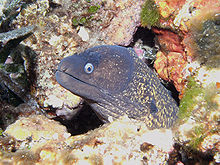- Mediterranean moray
-
Mediterranean moray 
Scientific classification Kingdom: Animalia Phylum: Chordata Class: Actinopterygii Order: Anguilliformes Family: Muraenidae Genus: Muraena Species: M. helena Binomial name Muraena helena
Linnaeus, 1758The Mediterranean moray (sometimes also called Roman eel, Muraena helena) is a fish of the moray eel family. It has a long eel-like body and is found in the eastern Atlantic Ocean and Mediterranean Sea. Its bite can be dangerous to humans.
Contents
Appearance and characteristics
The Mediterranean moray has an elongated, eel-like body and can reach a length of 1.5 meters and weigh over 15 kilograms. Its coloration varies from dark grey to dark brown with fine dark spots. The skin is slimy and without scales. The dorsal fin begins behind its head and continues to the caudal fin (fused with the anal fin). Pectoral fins are absent, teeth are long and sharp-pointed (like other morays), the mouth is long and robust and reaches behind the gills.
Evolution/phylogeny
Homologous feature
The Mediterranean moray is known for its ‘alien’-like pharyngeal jaw. A pharyngeal jaw works like a second jaw. The moray first bites into its prey with their first set of teeth then the pharyngeal jaw/teeth come forward. It is like a two-bone hook structure (as shown in the picture at this website, http://www.nytimes.com/2007/09/11/science/11eel.html?_r=1&ref=science&pagewanted=all&oref=slogin). It grabs the prey and drags it towards its oesophagus for swallowing. This is the only animal known to do so. The Mediterranean moray’s pharyngeal jaw is homologous to the jaws of many other ray-finned fish, for example, a parrot fish, which use their pharyngeal jaw for grinding their food. Scientists believe they came to have these ‘alien’-like jaws from being in tight spaces where the suction technique used by many other fish is not ideal. It also helps when trying to eat prey larger than itself. The Mediterranean moray used to have front fins. In the absence of these it is believed the muscles which used to support them now support the movement of the pharyngeal jaw. Other muscles still have the same attachments as those of other ray-finned fish like the parrot fish but which have become larger and longer.
Analogous feature
Although snakes and Mediterranean morays are not closely related, the body of the Mediterranean moray is analogous to that of a snake. It is structured differently but serves the same function. Their bodies of both are flexible for folding or coiling into small places, for example, crevices for the Mediterranean moray and under rocks for the snake. Both also use their bodies to slither from place to place whether it be in the water or on land. The pharyngeal jaw of the Mediterranean moray (which is explained above) is also analogous to the snake’s jaw. The right and left jaw of the snake unattach allowing the snake to eat larger pray than itself successfully. The pharyngeal jaw of the Mediterranean moray uses a different method and has a different structure than the snake's but the outcome, purpose and advantage are the same. These analogous features have evolved independently of each other as both animals have adapted to their environment.
Phylogeny
The closest relatives to the Mediterranean Moray are the many other species of morays. They are also closely related to bone fish, tarpon, ladyfish and saxpharynx fish. People commonly think that the electric eel and the Mediterranean moray must be very similar but in fact bony tongues , butterfly fish, elephant fish and featherbacks are closer on the tree of life. The electric eel and the Mediterranean moray do not show any relation until you go right back to its phylum, Chordata.
Ecology
The Mediterranean moray inhabits the coastal waters of the eastern Atlantic Ocean from the British Isles to the coast of Senegal; the waters of the Canary Islands and the Azores; and the Mediterranean Sea. It prefers rocky bottoms and lives in depths of from five to 80 meters. It is a solitary and territorial species. The Mediterranean moray spends most of the day in cavities and clefts between rocks and is more active at night. It hunts fishes, crayfishes and cephalopods, but also feeds on dead animals.
The Mediterranean moray's reproduction is not well known. They spawn about 60,000 eggs into open water, from which planktonic transparent leptocephali hatch.
One parasitic crustacean[1], the trematode Folliculovarium mediterraneum[2] and the flatworm Lecithochirium grandiporum[3] are parasites of the Mediterranean moray.
Human importance
The bite of the Mediterranean moray can be dangerous mainly due to the mildly toxic slime of its skin. It can be utilized fresh and eaten broiled, boiled and baked. The skin can be used for leather[4].
- Romans use to keep murenas in big pools. Sometimes for punishment, sometimes as pets or even for food. [1]
References
- ^ P.Sasal et al.,Determinants of parasite species richness in Mediterranean marine fishes, Mar.Ecol.Prog.Ser. Vol. 149: 61-71. 1997
- ^ Bartoli,B et al.First report of a species of Folliculovarium Gu & Shen, 1983 (Bucephalidae: Prosorhynchinae) from European marine waters, with the description of F. mediterraneum n. sp. Systematic Parasitology, Vol 56, Number 2, Oct. 2003
- ^ P.Bartoli1, D.I.Gibson, The status of Lecithochirium grandiporum (Rudolphi, 1819) (Digenea: Hemiuridae), a rarely reported and poorly known species from the Mediterranean moray eel Muraena helena L. in the Western Mediterranean. Systematic Parasitology, Vol 68, 3 Nov. 2007
- ^ Muraena helena, Mediterranean moray: fisheries, aquarium
Categories:- Muraenidae
- Animals described in 1758
Wikimedia Foundation. 2010.
